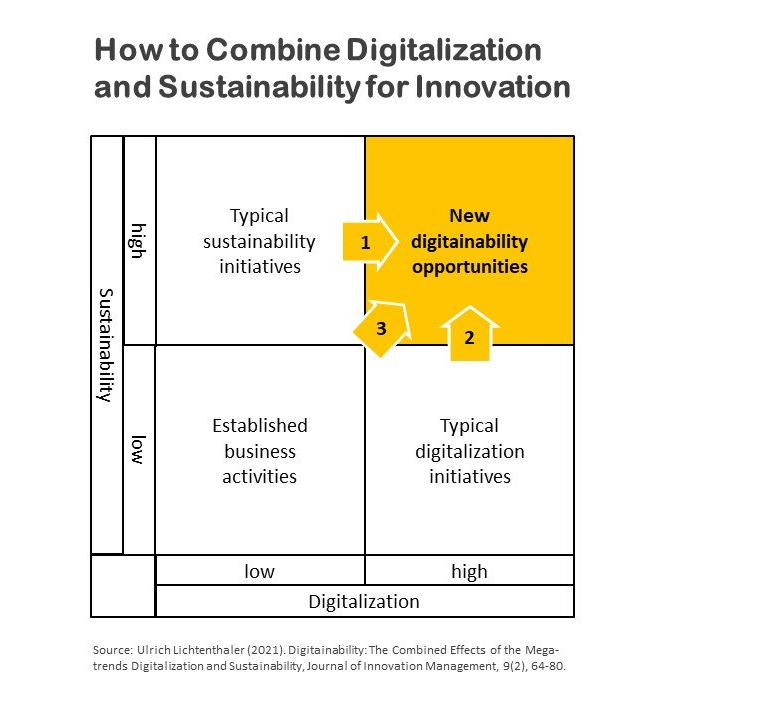Digitainability: Profiting from the combination of digitalization and sustainability
Ulrich Lichtenthaler • 9. November 2021
Many firms have started digital transformation and sustainability initiatives – but they neglect to profit from the combination of these two megatrends.
The term ‘digitainability’ has recently been coined in the academic literature to highlight relevant interdependencies between digitalization on the one hand and sustainability on the other. Actually, it does not really matter whether this specific term is used or whether companies refer to digital sustainability or sustainable digitalization instead. Much more important is the general awareness of interdependencies between these two megatrends. The variety of potential positive and negative interactions is addressed in my article entitled ‘Digitainability: The Combined Effects of the Megatrends Digitalization and Sustainability’, which has recently been published in the Journal of Innovation Management. The full text of the article
is available for free.
Digitalization and sustainability
The following abstract of the article gives a brief overview of its content: “The concept of digitainability has recently been suggested to underscore potential cross-fertilization effects between digitalization and sustainability, which have often been neglected. This conceptual article draws on an innovation-based view to develop a framework for combining digitalization and sustainability in firms’ strategic initiatives. It distinguishes four settings depending on whether firms pursue either digitalization or sustainability – or both or none of them to a strong degree. Beyond the individual importance of the two megatrends, their positive and negative interdependencies will gain further importance, and this article underscores the need for overcoming a potential dark side of digital solutions in terms of their carbon footprint and energy consumption to enable a sustainable digital transformation. In addition, digitainability offers the opportunity to move beyond optimization and cost savings due to digitalization and sustainability initiatives in order to capture the cross-fertilization potential of these two megatrends for innovation, business development, and sustainable design.” (Source)
Figure 1: Combining digitalization and sustainability (Source).
Innovation and business development
When discussing this topic with executives and with experts from other fields, many people can immediately highlight some positive or negative synergies of digitalization and sustainability in their work environment. Nonetheless, many large companies as well as startups often ignore these interfaces and continue to focus on relatively isolated digital transformation initiatives and sustainability programs. To some degree, it is understandable to manage digitalization and sustainability in a relatively separate way based on different responsibilities in an organization. At the same time, however, companies tend to leave major opportunities for innovation and new business development unconsidered if they do not address the cross-fertilization effects of their digitalization and sustainability programs. In the full text of my article, several examples for such effects are presented for companies from different sectors. If executives and managers have any touchpoints with digitalization and sustainability in their organizations, they should therefore have a close look at potential positive and negative interdependencies when planning activities, budgets, and goals for the next months and years.

Are you ‘PUMO ready’? Management tools for VUCA are insufficient in a PUMO world, which is Polarized, Unthinkable, Metamorphic, and Overheated. Since the initial blog post about my PUMO framework, the response has been overwhelming. Clearly, the concept has struck a nerve, and I have used it in multiple keynotes and workshops. PUMO goes beyond VUCA (Volatile, Uncertain, Complex, Ambiguous) and describes the world as increasingly: Polarized, Unthinkable, Metamorphic, Overheated. The interest in PUMO shows how urgently we need new frameworks to understand and lead in a hyper-dynamic business environment. If we accept the general relevance of the PUMO dimensions, how should companies and individuals proceed? This is the key question that I have addressed in a longer article in the International Journal of Innovation and Technology Management . This academic article shows that PUMO is not just another acronym requiring similar answers to VUCA. Instead, fundamentally new management approaches are necessary, and they are also a key part of my PUMO Management Workshop . If leaders and companies want to thrive in such an environment, they need the 4 Ps of PUMO Management: Positive, Proactive, Progressive, Purposeful. Positive positioning in response to 'Polarized' In a polarized world, staying positive is a strategic necessity because leaders and employees cannot afford to slip into negativity about the tendency to extremes with limited middle ground. Instead of trying to weigh in on every debate, smart companies and persons pick their battles and speak up only where it truly matters for them. The winning move today: keep the mindset upbeat, stay focused, and position your team and company selectively where you think it really matters and where your voice actually moves the needle. Proactive anticipation in response to 'Unthinkable' When the unthinkable becomes the new normal, which is never normal, leaders cannot just flexibly react. They need to think ahead and actively scan the horizon. Most ‘surprises’ are not actually that surprising, so anticipation, extreme scenario thinking, and investing in strategic options are essential. The strongest teams today combine proactive strategizing with real-time sensing, preparing not only for likely events but also for the extreme ones that could redefine their business overnight.

Sind Sie bereit für PUMO? Maßnahmen für VUCA reichen in einer PUMO Welt (Polarized, Unthinkable, Metamorphic, Overheated) nicht mehr aus. Seit meinem ersten Blogbeitrag zum PUMO Framework war die Resonanz überwältigend. Offensichtlich trifft das Konzept einen Nerv. Inzwischen habe ich PUMO in zahlreichen Vorträgen und Workshops eingesetzt. Der Ansatz geht bewusst über VUCA (Volatile, Uncertain, Complex, Ambiguous) hinaus und beschreibt die Welt als zunehmend: Polarized, Unthinkable, Metamorphic und Overheated. Das große Interesse an PUMO zeigt, wie dringend neue Ansätze benötigt werden, um in einem turbulenten Unternehmensumfeld Orientierung zu finden und wirksam zu führen. Vor dem Hintergrund der PUMO Welt stellt sich eine entscheidende Frage: Wie sollten Unternehmen und Führungskräfte jetzt handeln? Genau dieser Frage bin ich in einem ausführlicheren Artikel im International Journal of Innovation and Technology Management nachgegangen. Die zentrale Erkenntnis: PUMO ist nicht einfach nur ein neues Akronym. Vielmehr erfordert die PUMO Welt grundlegend andere Managementansätze als VUCA und diese bilden auch einen wesentlichen Bestandteil meines PUMO Management Workshops . Wer unter den aktuellen Bedingungen weiterhin erfolgreich bleiben möchte, benötigt die 4 Ps für PUMO Management: Positive, Proactive, Progressive, Purposeful. ‚Positive Positioning‘ als Antwort auf ‚Polarized‘ In einer polarisierten Welt ist eine positive Grundeinstellung eine strategische Notwendigkeit. Führungskräfte und Mitarbeitende können es sich nicht leisten, aufgrund zunehmend extremer Meinungen und wenig Raum für Kompromisse in eine negative Grundhaltung zu verfallen. Statt sich in jeder Debatte zu positionieren, wählen erfolgreiche Unternehmen und Führungskräfte ihre Themen bewusst aus. Sie beziehen dort Stellung, wo es für sie wirklich relevant ist und wo ihre Stimme Wirkung entfalten kann. Der entscheidende Erfolgsfaktor: ein positives Mindset, klare Fokussierung und eine selektive, bewusste Positionierung von Team und Organisation. ‚Proactive Anticipation‘ als Antwort auf ‚Unthinkable‘ Wenn das Undenkbare zur neuen Normalität wird, reicht reaktives Management nicht mehr aus. Führung erfordert vorausschauendes Denken und systematische Umfeldbeobachtung. Viele vermeintliche Überraschungen sind bei genauerem Hinsehen vorhersehbar. Deshalb sind Antizipation, extreme Szenarien und das Investieren in verschiedene strategische Optionen so wichtig. Erfolgreiche Unternehmen verbinden proaktive strategische Planung mit kontinuierlichem Monitoring in Echtzeit. Sie bereiten sich nicht nur auf wahrscheinliche Entwicklungen vor, sondern auch auf extreme Ereignisse, die ihr gesamtes Geschäftsmodell plötzlich verändern können.

In light of the AI evolution, there is a growing need for systematically addressing AI-based automation, augmentation, and integrated intelligence. What is happening? Currently, innovation management is changing faster than ever. In the past years and decades, we have witnessed already several big shifts: 2000s: Open innovation – bringing in ideas and knowledge from outside and use your own knowledge to collaborate with external partners. 2010s: Agile innovation – using speed and iteration with tools, such as lean startup and scrum, in order to deliver better results. Now: Smart innovation – using generative AI and agentic AI to make innovation processes smoother, faster, and more successful. Why does it matter? When adapting AI for enhancing innovation management, many firms currently focus on automation, thus using AI to take over repetitive tasks. While this is helpful, it overlooks the bigger prize: augmentation. AI should not just replace work, but also empower teams to think bigger, test faster, and achieve more with the same budget. This usually involves integrated intelligence , i.e. the combination of human and artificial intelligence. What are common pitfalls? Many companies quickly buy a particular AI tool without a clear strategy. Often, IT service providers push a single solution (their own solution), which may have some cool features, but which is not necessarily what the companies really need. Consequently, many of these (quite expensive) tools have limited impact, and this is true for adoption in small and large companies. What works for one company may not work for another. What is a smarter approach? Before investing in AI tools, you should ask yourself and your team several questions, for example: Where are our current pain points in the innovation process, e.g. where are resources being wasted or processes slowing down? Where are major gain points from using AI for enhancing innovation, e.g. where could it unlock the most opportunity in terms of faster prototyping, better customer insights etc.? Once you know these answers, you may choose the right AI tools and integrated them with your existing tools. Therefore, I give keynotes and run workshops with leadership and innovation teams to map out firm-specific gain points and pain points, to explore use cases for generative AI and agentic AI, and to build a roadmap for smart innovation which boosts the impact of your innovation budget. Smart innovation is not about chasing the latest shiny tool. Instead, it is about aligning AI with your strategy so every dollar spent works harder. For a free initial discussion about unlocking smart innovation opportunities, please contact me here .
A new business landscape calls for a whole new way of strategizing: Companies need to prepare for the PUMO world – Polarized, Unthinkable, Metamorphic, and Overheated. The February 2025 showdown between U.S. President Donald Trump and Ukrainian President Volodymyr Zelensky at the White House led to considerable shock and surprise across the globe, yet it is just another example of how fundamentally the world has changed in recent years. In this context, existing frameworks for understanding the broader business landscape are insufficient, for example VUCA (Volatile, Uncertain, Complex, Ambiguous) and BANI (Brittle, Anxious, Nonlinear, Incomprehensible). Firms constantly operate in contexts where these characteristics are nearly default settings. Consequently, these frameworks may still be helpful, but their marginal benefit is limited. They are not enough to successfully maneuver the global business landscape, where new challenges demand a novel approach with fresh business logic. Enter the PUMO framework (Polarized, Unthinkable, Metamorphic, Overheated), which enables a more relevant and actionable approach to succeeding in a shifting and turbulent environment. This is also addressed in detail in my new blog post about PUMO Management and in my PUMO Management Workshop . Polarized: Coping with major divides For several years, there has been a growing polarization about political, economic, social, and environmental topics. Rather than capturing multiple facets across a continuum, there is a tendency towards extremes with limited relevance of the middle ground. Stakeholders may expect firms to take clear positions, and just having a neutral spot regarding some topics becomes increasingly difficult. Multinational companies have the additional challenge of coping with contrasting demands based on different regional contexts worldwide. Beyond political, ESG , and AI topics, there may be specific business decisions that require a clear yes/no. Will a company decide in favor of supporting one major digital platform or another – and what implications will this have for its business in different regions across the globe? Such decisions may boost business and loyalty in some areas while leading to major challenges and problems in others. Thus, leaders need to understand the variety of divides and navigate them with strategic clarity. Unthinkable: Anticipating the unimaginable If companies try to prepare for the unexpected based on contingency plans, this may be a start, but it certainly is not enough. In recent years, we have witnessed a growing number of events, crises, and disruptions that traditionally would have been considered beyond the realm of possibility. Situations that are hard to predict or completely unpredictable may send shockwaves through the system of markets, industries, and business ecosystems. As difficult as it may be, companies need to prepare by trying to anticipate the unimaginable. Supposedly unthinkable news cannot be regarded as extremely rare exceptions, but they are an integral part of doing business. Firms need to react by strengthening their flexibility, nurturing their resilience, and broadening their strategic options. In addition, leaders need to be able and willing to fundamentally pivot and rethink their strategies at short notice while tactically adapting to specific situations in real time, and they may strategically prepare for this.

ChatGPT und generative KI werden uns nicht überflüssig machen – auch wenn die aktuelle Berichterstattung genau diesen Eindruck erweckt. ChatGPT hat uns allen verdeutlicht, wie schnell sich manche Felder künstlicher Intelligenz (KI) aktuell weiterentwickeln. Auch wenn einige dieser Entwicklungen schon seit Jahren erwartet wurden, ist die Geschwindigkeit vieler Verbesserungen selbst für manche ExpertInnen erstaunlich. Der aktuelle offene Brief des Future of Life Institute, der von über 1.000 Personen unterzeichnet wurde, ist daher grundsätzlich nachvollziehbar. Darin wird insbesondere auf die Risiken von KI hingewiesen und eine sechsmonatige Pause für das Trainieren leistungsfähiger KI-Lösungen gefordert. Eine ausreichende Beachtung der Risiken von KI ist unbedingt erforderlich, auch wenn die aktuelle Berichterstattung dazu oft zu kurz greift. Noch erstaunlicher ist aus betriebswirtschaftlicher Sicht jedoch das Medienecho der letzten Wochen und Monate zu den Auswirkungen von KI auf die Arbeitswelt, das sowohl in klassischen Medien als auch bei Social Media zu beobachten war. Dort wird häufig gefragt, ob wir als Menschen noch schlau genug sind im Vergleich zur KI. Auch wird diskutiert, ob KI künftig die meisten Führungskräfte ersetzen wird. Besonders oft steht also wieder einmal die Frage im Mittelpunkt, wie viele Personen durch KI ihren Job verlieren werden. Diese Frage ist auf den auf den ersten Blick vielleicht nachvollziehbar, weil durch KI-basierte Automatisierung in den nächsten Jahren tatsächlich in nennenswertem Umfang Jobs verloren gehen werden. Insbesondere werden auch solche Büro-Jobs betroffen sein, die bisher noch nicht automatisiert werden konnten. Dadurch sind mit offensiven Schlagzeilen sicherlich hohe Klickzahlen zu erreichen. Außerdem werden auch Arbeitsplätze in der Medienbranche automatisiert werden, wodurch sich die Berichterstattung zusätzlich erklären lässt. Integrierte Intelligenz strategisch oft wichtiger als eigenständige KI Dennoch wird viel zu oft ein einseitiger Schwerpunkt gelegt und damit auch ein falscher Eindruck vermittelt. Der wirklich entscheidende Teil der Entwicklung für die meisten Unternehmen und ebenso für die meisten Arbeitskräfte liegt in der Kombination von KI mit menschlicher Arbeit – und eben gerade nicht in der vollständigen Automatisierung von Jobs durch KI. In den letzten Jahren kamen verschiedenen Studien immer wieder zu ähnlichen Ergebnissen. Der Grundtenor ist dahingehend identisch, dass sich deutlich mehr Jobs verändern werden als komplett wegzufallen (vor allem, wenn die Zahl der Arbeitsplätze berücksichtigt wird, die durch KI zusätzlich entstehen). Diese Kombination von menschlicher mit künstlicher Intelligenz wird auch als integrierte Intelligenz bezeichnet.









